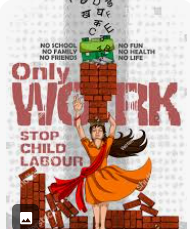Title: Eradicating Child Labour: A Call for Global Action
Introduction:
Child labour is a persistent and deeply troubling issue that deprives millions of children worldwide of their childhood, education, and basic rights. Defined by the International Labour Organization (ILO) as work that deprives children of their childhood, potential, and dignity, and is harmful to their physical and mental development, child labour remains a significant challenge despite international efforts to address it. This essay examines the causes and consequences of child labour, the global efforts to combat it, and the urgent need for coordinated action to eliminate this scourge.
Understanding Child Labour:
Child labour encompasses a wide range of activities and occupations, from hazardous work in mines and factories to domestic service, agriculture, and informal street vending. It affects children of all ages, but is most prevalent among the poorest and most marginalized communities, where families struggle to meet their basic needs and children are forced to contribute to household income.
The root causes of child labour are complex and interconnected, stemming from poverty, lack of access to education, social inequality, discrimination, and inadequate legal protections. In many cases, children are forced into labour by economic necessity, while others are exploited by unscrupulous employers who prey on their vulnerability and lack of legal protections.
Consequences of Child Labour:
Child labour has devastating consequences for children, families, and communities, perpetuating cycles of poverty and deprivation. It denies children their right to education, trapping them in a cycle of illiteracy and limited opportunities for social and economic advancement. Moreover, child labour exposes children to physical, emotional, and psychological harm, as they are often subjected to dangerous working conditions, long hours, and exploitation.
The impact of child labour extends beyond individual children, affecting entire communities and societies. It undermines efforts to achieve sustainable development goals, perpetuates social inequality, and stifles economic growth by perpetuating low-wage labor and preventing children from reaching their full potential. Furthermore, child labour contributes to the intergenerational transmission of poverty, as children who are denied education and opportunities for development are more likely to remain trapped in poverty as adults.
Global Efforts to Combat Child Labour:
Over the past few decades, significant progress has been made in raising awareness of child labour and mobilizing global action to address it. The adoption of international conventions such as the ILO's Convention No. 182 on the Worst Forms of Child Labour and the United Nations Convention on the Rights of the Child has provided a framework for governments, civil society organizations, and the private sector to work together to combat child labour.
Additionally, numerous initiatives and programs have been launched to tackle the root causes of child labour, including poverty alleviation, access to education, social protection, and enforcement of labor laws. Multilateral organizations such as the ILO, UNICEF, and the World Bank have played a key role in providing technical assistance, funding, and expertise to support countries in their efforts to eliminate child labour.
However, despite these efforts, child labour persists as a widespread and entrenched problem, particularly in regions where poverty, conflict, and social instability are prevalent. Millions of children continue to toil in hazardous conditions, denied their fundamental rights and robbed of their childhood.
The Urgent Need for Action:
To effectively address child labour, concerted and coordinated action is needed at the global, national, and local levels. Governments must prioritize the eradication of child labour through comprehensive legislative frameworks, enforcement mechanisms, and social protection programs. They must invest in education, vocational training, and social services to provide children with viable alternatives to labor exploitation.
The private sector also has a crucial role to play in combating child labour by ensuring ethical supply chains, enforcing labor standards, and promoting responsible business practices. Consumers can contribute to these efforts by making informed choices and supporting companies that prioritize ethical production and respect for human rights.
Furthermore, civil society organizations, including non-governmental organizations, community groups, and advocacy networks, play a vital role in raising awareness, providing support services, and advocating for policy change. By working together in partnership with governments, the private sector, and affected communities, they can amplify their impact and drive meaningful change.
Conclusion:
Child labour is a grave violation of children's rights and a barrier to sustainable development. It robs children of their childhood, denies them opportunities for education and personal development, and perpetuates cycles of poverty and inequality. However, it is not an insurmountable problem. With political will, collective action, and sustained investment, we can eradicate child labour and create a world where every child can thrive, learn, and fulfill their potential.

